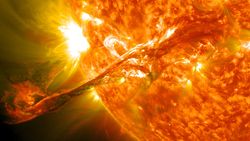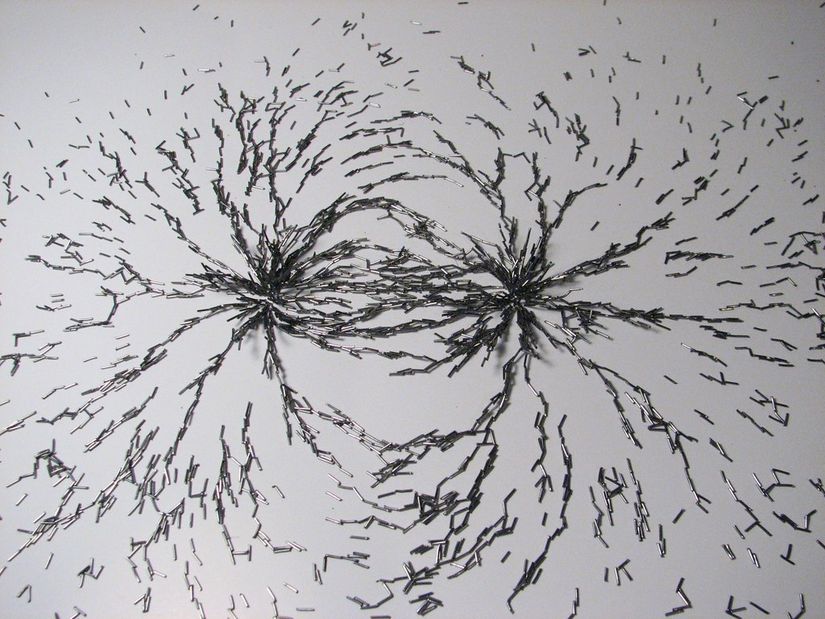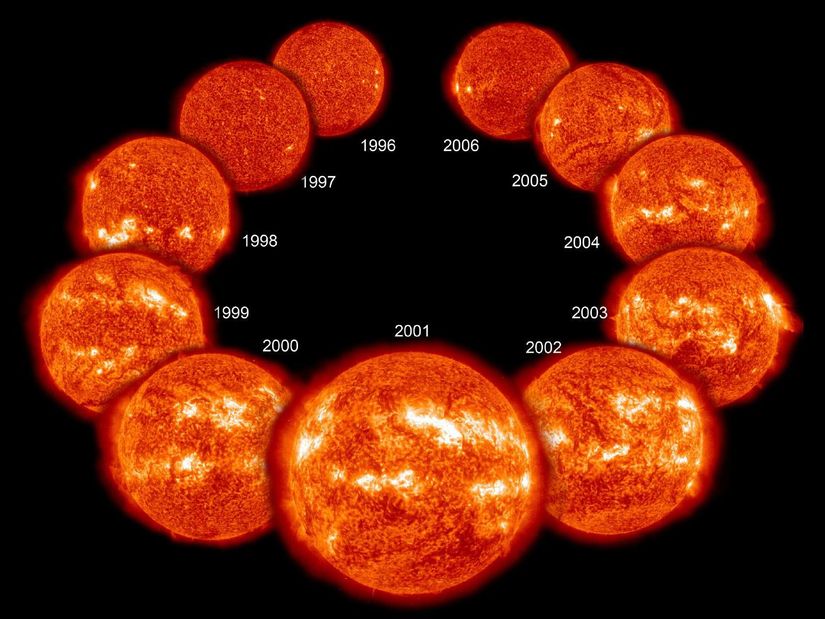What Are Solar Flares? How Are They Different Than Coronal Mass Ejections? How Do These Violent Explosions Occur?
 Wikimedia
Wikimedia
- Blog Yazısı
Our beautiful Sun gives our planet life, but that does not mean it is always so helpful to preserving that life. In fact, one theory states that the immense energy discharged by the Sun caused the atmosphere of Mars to be destroyed and currently this theory is being studied by NASA, using the MAVEN spacecraft.[1] Everyone can feel the power of the Sun, especially on a warm summer day, and inherently know that the surface of the Sun would not be hospitable to any visitors. And sometimes, this inhospitably, is violently ejected in our direction by what we call "solar flares".
A solar flare is a sudden explosion of energy on the Sun's surface that arises from the violent electromagnetic interactions within our star. Even though it is usually used synonymously with "coronal mass ejections", a solar flare is not necessarily accompanied by a coronal mass ejection, i.e. the sudden and significant release of plasma and magnetic fields. In other words, the Sun may experience solar flares with no coronal mass ejections. For instance, the following Class X5.4 solar flare was captured on March 6, 2012 (no apparent coronal mass ejections occured, though a very powerful shockwave can be seen):
While usually only lasting a few minutes, solar flares will sometimes also eject billions of tons of charged particles at more than 600-1400 mph (965-2250 kph) into the Solar System. As these particles are traveling away from the Sun, they are called "solar wind".

Since the solar flare ejections are charged particles, they interact with the electromagnetic fields and cause radiation on the radio and X-ray wavelengths. If these solar flares are powerful enough, they can reach to the interplanatary space. These flares are usually accompanied by coronal mass ejections, which is in turn called "interplanetary coronal mass ejection" (or "ICME", in short). These highly charged particles can collide with Earth's magnetosphere and cause what is known as "geomagnetic storms" - highly chaotic perturbations to the magnetic field of the Earth, resulting in loss of communication, unexpected behaviours in digital technologies, and/or noise in electronic devices.

How Do Solar Flares Form?
The Sun's surface is an interesting place: the Sun is made of "plasma", that is an electrically charged gas-like matter where electrons and ions have separated.[2] When these particles move around on the Sun's magnetic fields on the surface, they in turn influence these magnetic fields. The magnetic fields on the Sun are mainly created by the nuclear fusion that occurs in the center of the Sun. A reaction is called a "fusion reaction" when smaller atoms like Hydrogen are fused under immense pressure and temperature to form larger atoms like Helium, releasing huge amounts of energy in the process. This nuclear reaction is what gives the Sun its source of massive heat.
This interplay of all of these dynamic magnetic fields and enormous heat sets the stage for plasma to "explode". The exact mechanism of this process is still being studied, but researchers use models to show these magnetic fields, as these are known to being the factor that leads to explosions.
One explanation is as follows: Under this immense pressure and temperature, the electromagnetism in the Sun behaves much more differently and violently than what we are used to here on Earth. Normally, you might know how magnetic fields behave around a magnet. They form somewhat organized, singular lines that leave the north pole of the magnet and go into the south pole, as follows:
 Windell Oskay
Windell OskayOnce these electromagnetic lines are formed, they are not expected to break under normal conditions, meaning they always leave the same spot and connect to the same spot. Nor do they ever intersect each other. However, on the surface of the Sun where the conditions are wildly chaotic, the magnetic lines are forced to connect and reconnect, a process known as magnetic reconnection. When a magnetic reconnection happens, an immense amount of energy is released within minutes, which is what is known as "solar flares".
Sunspots and Solar Cycle
In some places of the Sun, the magnetic fields are stronger than others. You may have heard of sunspots. These are cooler parts of the Sun - well if you can call ~3500 Kelvins (or 6400 degrees Fahrenheit) "cool".[3] The sunspots have magnetic fields that are so strong that they repel the heat inside of the Sun from reaching the surface due to the "magnetic pressure" they cause. You can think this as magnetic fields pushing the heat into the surface of the Sun, as explained above.
These sunspots have been observed since Galileo Galilei's time (around 1609) and in the 19th century Samuel Schwabe determined that these sunspots follow a "cycle" in their movements, what we call the Solar Cycle: The solar cycle, over the course of 11 years will go from being active, to quiet, to being active, starting the next cycle.

Interestingly, the sunspots have been the longest natural phenomena humans have ever recorded in our written history. Yet, we have a lot to learn from the Sun, its cycles, and its flares: In 2020, as part of an international collaboration of a Sun-observing mission, researchers took the closest images of the sun to date with the Solar Orbiter Spacecraft. What they found were "campfires" that are described as being mini-explosions known as nanoflares or miniature solar flares.[4]
Aslında maddi destek istememizin nedeni çok basit: Çünkü Evrim Ağacı, bizim tek mesleğimiz, tek gelir kaynağımız. Birçoklarının aksine bizler, sosyal medyada gördüğünüz makale ve videolarımızı hobi olarak, mesleğimizden arta kalan zamanlarda yapmıyoruz. Dolayısıyla bu işi sürdürebilmek için gelir elde etmemiz gerekiyor.
Bunda elbette ki hiçbir sakınca yok; kimin, ne şartlar altında yayın yapmayı seçtiği büyük oranda bir tercih meselesi. Ne var ki biz, eğer ana mesleklerimizi icra edecek olursak (yani kendi mesleğimiz doğrultusunda bir iş sahibi olursak) Evrim Ağacı'na zaman ayıramayacağımızı, ayakta tutamayacağımızı biliyoruz. Çünkü az sonra detaylarını vereceğimiz üzere, Evrim Ağacı sosyal medyada denk geldiğiniz makale ve videolardan çok daha büyük, kapsamlı ve aşırı zaman alan bir bilim platformu projesi. Bu nedenle bizler, meslek olarak Evrim Ağacı'nı seçtik.
Eğer hem Evrim Ağacı'ndan hayatımızı idame ettirecek, mesleklerimizi bırakmayı en azından kısmen meşrulaştıracak ve mantıklı kılacak kadar bir gelir kaynağı elde edemezsek, mecburen Evrim Ağacı'nı bırakıp, kendi mesleklerimize döneceğiz. Ama bunu istemiyoruz ve bu nedenle didiniyoruz.
Coronal Mass Ejections and Solar Energetic Particles
A solar flare can be accompanied by a Coronal Mass Ejection (CME) and Solar Energetic Particles (SEP). A CME is magnetized plasma that has been ejected from the Sun's outermost atmosphere called the "corona". This magnetized plasma that has been ejected will contain electrons and protons. A CME may be produced by the Sun several times a day to one in every five days, depending on the "solar cycle" the sun is currently in.[5] An SEP also consists of protons, electrons, and what is known as HZE ions. These ions are highly energetic rays that are dispersed into the Universe.
Impact of Solar Flares on Earth
These solar flares can impact the Earth by damaging satellites and exposing plane passengers to high amounts of radiation. Without the protection of an atmosphere astronauts on the Moon or on their way to Mars can be hit by the charged particles that can lead to damage to human cells and tissues unless a physical or magnetic shielding is used.
It usually takes days for the ejected particles to reach Earth, giving enough time for a response; however, on January 20, 2005, a solar flare happened that resulted in dangerous charged particles surrounding the Earth and Moon not in days or hours, but within minutes. If astronauts had been on the Moon, there would have not been enough time to seek shelter from the particles.

On September 6, 2017 the largest solar flare of the decade was observed in Sunspot 2673. It was such a powerful solar flare that the accompanying coronal mass ejection created a strong shortwave radio blackout over Europe, Africa, and the Atlantic Ocean.
Conclusion
Without the Sun, there would be no Earth, let alone life on Earth. The Sun is one of the most common types of stars that we find in our galaxy. Therefore it is crucial to study this closest star to our planet in order to understand how stars, star systems, planets, and life on those planets form and evolve over time. Who knows, maybe we will find life on a planet around another Sun-like star one day...
- 1
- 0
- 0
- 0
- 0
- 0
- 0
- 0
- 0
- 0
- 0
- 0
- ^ NASA Solar System Exploration. In Depth | Maven – Nasa Solar System Exploration. Alındığı Tarih: 10 Ağustos 2021. Alındığı Yer: NASA Solar System Exploration | Arşiv Bağlantısı
- ^ S. Frazier. Understanding The Magnetic Sun. (28 Ocak 2016). Alındığı Tarih: 10 Ağustos 2021. Alındığı Yer: NASA | Arşiv Bağlantısı
- ^ Space.com. What Are Sunspots?. (1 Mart 2012). Alındığı Tarih: 10 Ağustos 2021. Alındığı Yer: Space.com | Arşiv Bağlantısı
- ^ M. Hatfield. Solar Orbiter Returns First Data, Snaps Closest Pictures Of The Sun. (15 Temmuz 2020). Alındığı Tarih: 10 Ağustos 2021. Alındığı Yer: NASA | Arşiv Bağlantısı
- ^ N. Fox. Coronal Mass Ejections. (10 Ağustos 2021). Alındığı Tarih: 10 Ağustos 2021. Alındığı Yer: Nasa.gov | Arşiv Bağlantısı
Evrim Ağacı'na her ay sadece 1 kahve ısmarlayarak destek olmak ister misiniz?
Şu iki siteden birini kullanarak şimdi destek olabilirsiniz:
kreosus.com/evrimagaci | patreon.com/evrimagaci
Çıktı Bilgisi: Bu sayfa, Evrim Ağacı yazdırma aracı kullanılarak 09/12/2025 07:23:17 tarihinde oluşturulmuştur. Evrim Ağacı'ndaki içeriklerin tamamı, birden fazla editör tarafından, durmaksızın elden geçirilmekte, güncellenmekte ve geliştirilmektedir. Dolayısıyla bu çıktının alındığı tarihten sonra yapılan güncellemeleri görmek ve bu içeriğin en güncel halini okumak için lütfen şu adrese gidiniz: https://evrimagaci.org/s/10839
İçerik Kullanım İzinleri: Evrim Ağacı'ndaki yazılı içerikler orijinallerine hiçbir şekilde dokunulmadığı müddetçe izin alınmaksızın paylaşılabilir, kopyalanabilir, yapıştırılabilir, çoğaltılabilir, basılabilir, dağıtılabilir, yayılabilir, alıntılanabilir. Ancak bu içeriklerin hiçbiri izin alınmaksızın değiştirilemez ve değiştirilmiş halleri Evrim Ağacı'na aitmiş gibi sunulamaz. Benzer şekilde, içeriklerin hiçbiri, söz konusu içeriğin açıkça belirtilmiş yazarlarından ve Evrim Ağacı'ndan başkasına aitmiş gibi sunulamaz. Bu sayfa izin alınmaksızın düzenlenemez, Evrim Ağacı logosu, yazar/editör bilgileri ve içeriğin diğer kısımları izin alınmaksızın değiştirilemez veya kaldırılamaz.









